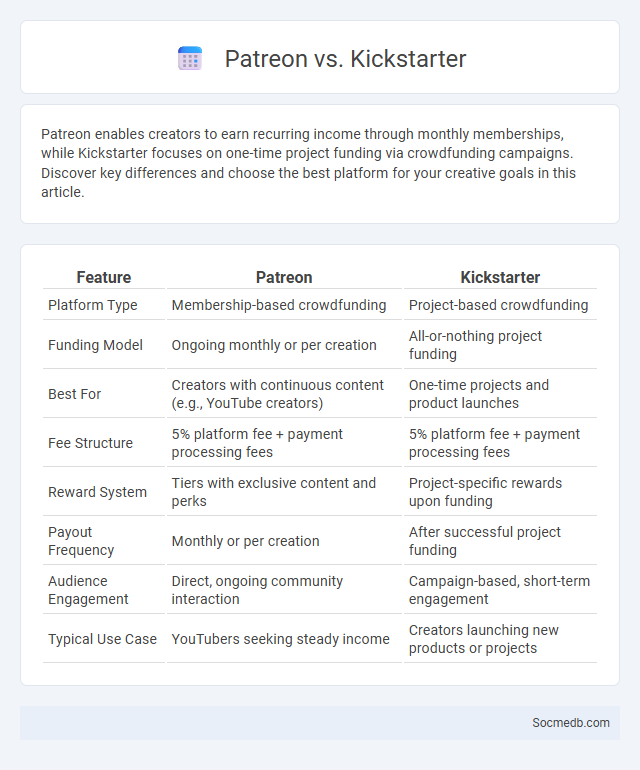
Photo illustration: Patreon vs Kickstarter
Patreon enables creators to earn recurring income through monthly memberships, while Kickstarter focuses on one-time project funding via crowdfunding campaigns. Discover key differences and choose the best platform for your creative goals in this article.
Table of Comparison
| Feature | Patreon | Kickstarter |
|---|---|---|
| Platform Type | Membership-based crowdfunding | Project-based crowdfunding |
| Funding Model | Ongoing monthly or per creation | All-or-nothing project funding |
| Best For | Creators with continuous content (e.g., YouTube creators) | One-time projects and product launches |
| Fee Structure | 5% platform fee + payment processing fees | 5% platform fee + payment processing fees |
| Reward System | Tiers with exclusive content and perks | Project-specific rewards upon funding |
| Payout Frequency | Monthly or per creation | After successful project funding |
| Audience Engagement | Direct, ongoing community interaction | Campaign-based, short-term engagement |
| Typical Use Case | YouTubers seeking steady income | Creators launching new products or projects |
Introduction: Overview of Patreon, Kickstarter, and Fan Funding
Patreon, Kickstarter, and fan funding platforms revolutionize content creator support by enabling direct audience contributions. Patreon offers subscription-based membership models, providing creators with steady monthly income, while Kickstarter focuses on project-based crowdfunding to finance creative ventures. Fan funding blends these elements, empowering supporters to invest in creators' ongoing work and exclusive content.
How Patreon Works: Subscription-Based Support
Patreon operates as a subscription-based platform enabling creators to receive recurring financial support directly from their fans, called patrons. Creators offer exclusive content, early access, or special perks in exchange for monthly membership fees set at various tiers. This model fosters a sustained income stream for artists, writers, podcasters, and other content creators by building a dedicated community around their work.
How Kickstarter Works: Project-Based Crowdfunding
Kickstarter operates as a project-based crowdfunding platform where creators present detailed campaign pages to attract backers for specific projects. Backers pledge funds in exchange for rewards or early access, with projects only receiving funding if they meet their target goals. This model encourages transparency and community engagement, driving social media buzz to amplify project visibility and reach.
Understanding Fan Funding: Direct Support Models
Understanding fan funding involves recognizing how platforms like Patreon, Ko-fi, and Buy Me a Coffee enable creators to receive direct financial support from their audience. This model empowers Your favorite artists or content producers to monetize their work through subscriptions, one-time donations, or exclusive content access. Implementing a transparent and engaging fan funding strategy can enhance community loyalty and provide sustainable revenue streams.
Key Differences Between Patreon, Kickstarter, and Fan Funding
Patreon enables creators to receive ongoing support through monthly subscriptions, ideal for continuous content production, while Kickstarter focuses on one-time crowdfunding for specific projects with set goals and deadlines. Fan Funding options, such as YouTube Super Chat or Twitch donations, provide immediate financial support during live streams or content releases. Understanding these distinctions allows you to choose the best platform to monetize your creative work effectively.
Pros and Cons of Patreon for Creators
Patreon offers creators a reliable income stream through fan subscriptions, enabling financial independence and direct community engagement. The platform supports diverse content types, but fees can reduce overall earnings and the subscription model may limit audience growth compared to ad-based revenue. Creators benefit from Patreon's tools for exclusive content delivery, though reliance on the platform involves risks related to policy changes or account suspension.
Pros and Cons of Kickstarter for Creators
Kickstarter offers creators a powerful platform to showcase innovative projects and gain funding directly from enthusiastic backers, fostering community engagement and market validation. However, the all-or-nothing funding model and high competition can pose financial risks and pressure to meet delivery deadlines, potentially impacting Your project's success and reputation. Careful project planning and transparent communication with supporters are essential to maximize the benefits and mitigate the challenges of using Kickstarter for creative ventures.
Benefits and Challenges of Fan Funding
Fan funding on social media empowers creators to directly monetize their content while fostering a loyal community of supporters, enhancing engagement and creative freedom. Challenges include managing inconsistent income streams, addressing platform fees, and ensuring transparent communication to maintain trust with Your audience. Strategic use of multiple funding platforms can optimize revenue stability and fan satisfaction.
Which Platform is Best for Your Creative Project?
Choosing the best social media platform for your creative project depends on your target audience and the type of content you produce. Instagram excels in visual storytelling with its focus on photos and short videos, making it ideal for artists, photographers, and designers. TikTok offers dynamic short-form video content perfect for engaging younger audiences through trends and challenges, while YouTube provides extensive support for long-form videos, tutorials, and detailed creative processes.
Final Comparison: Choosing the Right Funding Model
Choosing the right funding model for social media platforms directly impacts your user experience and content quality. Subscription-based models often provide ad-free environments, enhancing privacy and engagement, while ad-supported platforms offer free access but may compromise on data usage and add distractions. Evaluating your preferences for cost, privacy, and content will guide you to the most suitable social media funding approach.
 socmedb.com
socmedb.com